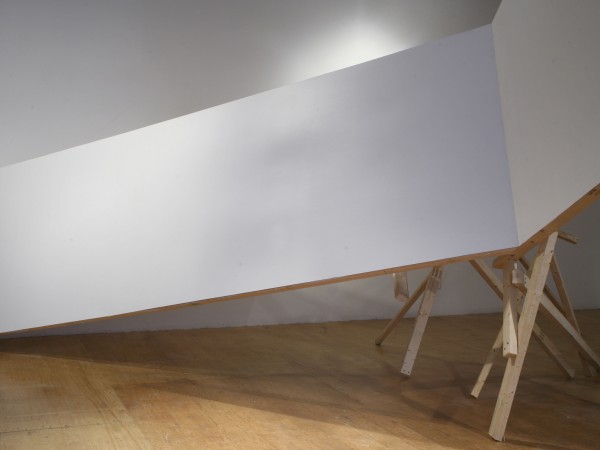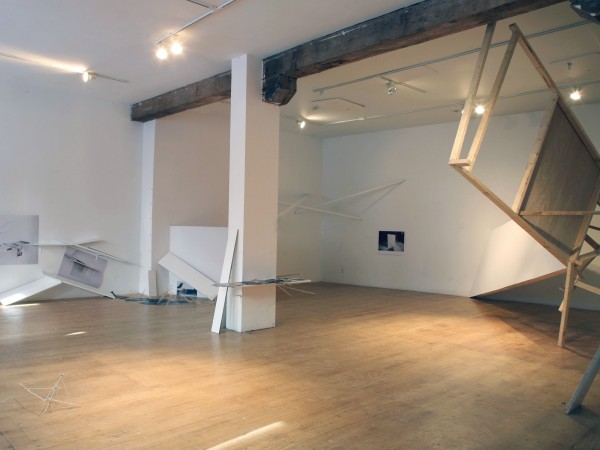Possible Worlds
par Annie Hudon Laroche
Erik Olofsen
from January 7 to February 24, 2008
In our spirit, spaces overlap. Our view of the world is colored by the construct of space, both those in which we live and the space of fiction constituted by images and other forms of representation. The boundaries and poles that were once used to mark out our view of the world are fading, enabling us to see gain a glimpse of the transitory spaces that constitute this world. The spaces in question are open, spaces of possibility, to paraphrase the title of Erik Olofsen’s residency Possible Worlds. And so it was that Olofsen transformed the exhibition space at LA CHAMBRE BLANCHE into a veritable laboratory of creation, employing time as means of deconstructing space, thereby revealing the spatial relations with which temporality is bound.
Erik Olofsen’s work evoked the feeling of being on a construction site whose purpose had deliberately been left uncertain, as he transformed the space into an exploratory work in progress. Olofsen’s approach to space echoes Michel de Certeau’s concept of “space as a practice of place.”1The forms of mobility and movement arising from the artist’s actions during his residency engendered such a feeling. A fixed and stable place was thus transformed into a space of movement inscribing Olofsen’s work an in-between space charged with possibilities. The spatial dynamic created was enabled by a play with deceptively ordinary structures which acted as vectors in the space. During the creative process, the artist created assemblages from strips of wood, which protruded from the gallery walls or were placed on the floor, resembling parts of models or shelving. These structures combined with a large quantity of images that were either fixed to the wall, or spread out randomly on the gallery floor.
Olofsen’s creation of a sense of dislocation in the exhibition space unsettled viewers’ perception of the artist. As a critic of the omnipresence of the image in our experience of space, Erik Olofsen used his residency at LA CHAMBRE BLANCHE to pursue a body of work that began with the poetic exploration of Mental Pollution (2007), this time focusing his research on the way that our sense of space is effected. The space set in motion by the artist was above all a sensory space, of both precision and ambiguity, in which a variety of elements were interrelated, each echoing the other, as well as responding to the features of the gallery (the angle of windows, luminosity etc.) Thus, the shape of the work emerged through a network of complex interrelations. Erik Olofsen’s Possible Worlds revealed a number of mechanisms of cognition, not by employing the lure or charm of illusion, but rather by simultaneously staging a number of temporalities and spatial forms, thereby creating slippages in perception. Thus we experienced a deconstruction of space that foregrounded the complexity of perception.
Two key procedures employed by the artist to unsettle the gaze are those of doubling and mise en abîme. The tone is set upon entering the space of Possible Worlds, as we encounter the underside of a large structure held together with an assemblage of wood that seems both incongruous and precarious. The same wooden assemblage is reprised in a photograph elsewhere in the exhibition. Visitors have only to scan the space to catch sight of another doubling of structures, in the form of full-scale images of shelving on a wall, placed alongside the real structures that they represent. For all viewers inclined to be the least bit curious and attentive, the game is already underway: that of seeking out possible combinations and correspondences between two and three-dimensional forms in space. This play on the space between fiction and structure – at times breathtaking – was underscored by the use of mise en abîme processes in the exhibition space. For example, an assemblage composed of small pieces of multicolored wood and elastic was pictured in a photograph, next to another image depicting a similar structure, placed beside a third photograph of the composition. Thus structural, fictional and imaginary spaces are interwoven within the core of our perception. Our gaze is unsettled by the juxtaposition and repetition of similar elements in the space, but also the presence of photographs that depict various stages of the creative process. A form of living memory emerges in the evolving space of the residency project. The past, present and future of the work appear side by side; photographs of the space prior to the project were on show early on, inviting the viewer to speculate on the transformations to which the space would be subject later on in the residency. Thus, visitors to the space are repeatedly invited to reevaluate the space in which they find themselves, through the range of photographic imagery and points of view with which they are confronted. That said, a certain distance emerges between our initial encounter and later perception of the space, enabling the shaping of a critical perspective on the project.
Possible Worlds offered a space of reflection, enabling the setting aside of fixed, stable and singular view points that emphasize functionality, in order to explore and experiment with the experience of fleeting spaces. As shown, these spaces came to the fore through our temporal experience of space, as well as our experience of moving between physical and cognitive forms. The artist’s focus on strategies of doubling, juxtaposition and mise en abîme enabled the activation of such fleeting spaces and the dawning of a sense of the richness and complexity of these worlds.
- Certeau, Michel de. 1980, L’invention du quotidien, Arts de faire tI. Paris: Gallimard Editions, p. 172.


